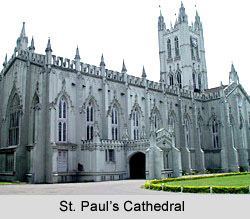 St. Paul`s Cathedral is one of the Anglical churches which was established in Kolkata in 1847 which is associated with the anglical community of Kolkata. While the foundation of this church was laid in 1839, it was completed in 1847. This church is well known for its British legacy and carrier of Christianity which describes the secular character of Kolkata. As Kolkata is a home of diverse religions out of which Christians occupy a massive portion. This Church plays a major role in executing the central power that controls all the churches in rest of Kolkata as well as West Bengal. This Church has been the seat of the Bishop of Kolkata who exercised sole leadership over the Churches of North India. Away from the crowd this church is located in the southern end of Maidan and east of the Victoria Memorial.
St. Paul`s Cathedral is one of the Anglical churches which was established in Kolkata in 1847 which is associated with the anglical community of Kolkata. While the foundation of this church was laid in 1839, it was completed in 1847. This church is well known for its British legacy and carrier of Christianity which describes the secular character of Kolkata. As Kolkata is a home of diverse religions out of which Christians occupy a massive portion. This Church plays a major role in executing the central power that controls all the churches in rest of Kolkata as well as West Bengal. This Church has been the seat of the Bishop of Kolkata who exercised sole leadership over the Churches of North India. Away from the crowd this church is located in the southern end of Maidan and east of the Victoria Memorial.
St. Paul`s Cathedral exhibits a beautiful architectural pattern and was the first `Episcopal Cathedral Church` to be set up in an oriental country`. The Church displayed Indo-Gothic pattern of architecture and it took Rs 5 lakhs for the construction. The St. Paul`s Cathedral, Kolkata church was built under the sponsorship of Bishop Wilson. Major Forbes of the Bengal Engineers` Association proposed the plans for the construction. The Cathedral is renowned for its splendour and it also has a stained glass panel in the west window, dedicated to honour Lord Mayo who was assassinated in the Andaman Islands. Sir Edward Burne-Jones designed this memoir. There are many such memorials inside the cathedral, and still now they have been preserved properly. These preserved memorials form a link between the past and the present and entices the visitors to the Cathedral. The height of the Church tower is 201 ft. and it is 247 ft. long with the width measuring 81 ft.
St. Paul`s Cathedral, one is amazed to see the beautifully decorated large cathedral hall. It has marvellously carved wooden pews and chairs along the west stained glass window; the eastern walls are covered with intricate artwork, which attracts the eye, which are the two Florentine frescoes. The whole artwork is a visual treat for the onlookers; the floral designs that adorn them are so unique and artistic. The Mural paintings lend a majestic touch to the whole ambience. The Church contains pictures, which are basically the life and work of St. Paul, and they are extensive in their portrayal. The worldly remains of Bishop Wilson are preserved in a coffin that is situated inside the underground chamber. He was conferred the commission plate by Queen Victoria and this till now finds a place among the displayed things out there.
St. Paul`s Cathedral that is decorated with the frescoes of Florentine renaissance style has been well known for being a place of worship which relaxes the minds and soul of people. As a small place of meditation this place has not only attracted the Christians of Kolkata but also other tourists who are free to enjoy the peace of the church along with its scenic beauty.
Thus as one of the important tourist spots of Kolkata this place is considered along with Victoria Memorial which stands just besides this church.



















